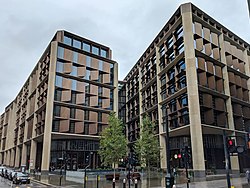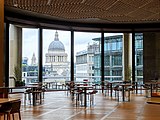
Mithraism, also known as the Mithraic mysteries or the Cult of Mithras, was a Roman mystery religion centered on the god Mithras. Although inspired by Iranian worship of the Zoroastrian divinity (yazata) Mithra, the Roman Mithras is linked to a new and distinctive imagery, with the level of continuity between Persian and Greco-Roman practice debated. The mysteries were popular among the Imperial Roman army from about the 1st to the 4th-century CE.
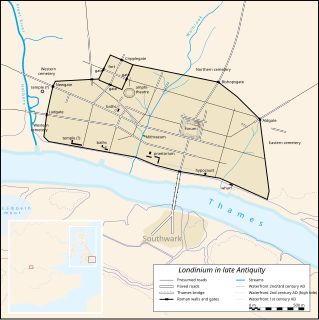
Londinium, also known as Roman London, was the capital of Roman Britain during most of the period of Roman rule. It was originally a settlement established on the current site of the City of London around AD 47–50. It sat at a key crossing point over the River Thames which turned the city into a road nexus and major port, serving as a major commercial centre in Roman Britain until its abandonment during the 5th century.

Bank and Monument are interlinked London Underground and Docklands Light Railway (DLR) stations that form a public transport complex spanning the length of King William Street in the City of London. Bank station, named after the Bank of England, opened in 1900 at Bank junction and is served by the Central, Northern and Waterloo & City lines, and the DLR. Monument station, named after the Monument to the Great Fire of London, opened in 1884 and is served by the District and Circle lines. The stations have been linked as an interchange since 1933.

The London Mithraeum, also known as the Temple of Mithras, Walbrook, is a Roman Mithraeum that was discovered in Walbrook, a street in the City of London, during a building's construction in 1954. The entire site was relocated to permit continued construction and this temple of the mystery god Mithras became perhaps the most famous 20th-century Roman discovery in London.
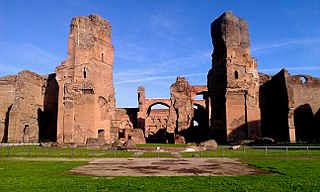
The Baths of Caracalla in Rome, Italy, were the city's second largest Roman public baths, or thermae, after the Baths of Diocletian. The baths were likely built between AD 212 and 216/217, during the reigns of emperors Septimius Severus and Caracalla. They were in operation until the 530s and then fell into disuse and ruin.

25 Bank Street is an office tower in Canary Wharf, in the Docklands area of London. It is currently home to the European headquarters of the investment bank JPMorgan Chase.

A Mithraeum(Latin pl. Mithraea), sometimes spelled Mithreum and Mithraion, is a Mithraic temple, erected in classical antiquity by the worshippers of Mithras. Most Mithraea can be dated between 100 BC and 300 AD, mostly in the Roman Empire.
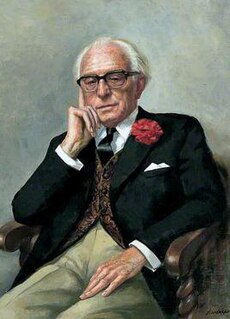
William Francis Grimes was a Welsh archaeologist. He devoted his career to the archaeology of London and the prehistory of Wales. He was appointed a CBE in 1955.

The Walbrook is a subterranean river in the City of London that gave its name to the Walbrook City ward and a minor street in its vicinity.
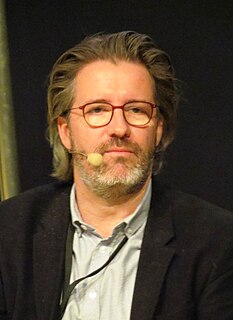
Olafur Eliasson is an Icelandic–Danish artist known for sculptured and large-scale installation art employing elemental materials such as light, water, and air temperature to enhance the viewer's experience. In 1995 he established Studio Olafur Eliasson in Berlin, a laboratory for spatial research. In 2014, Eliasson and his long-time collaborator, German architect Sebastian Behmann founded Studio Other Spaces, an office for architecture and art. Olafur represented Denmark at the 50th Venice Biennale in 2003 and later that year installed The Weather Project, which has been described as "a milestone in contemporary art", in the Turbine Hall of Tate Modern, London.

Augusta Emerita, also called Emerita Augusta, was a Roman colonia founded in 25 BC in present day Mérida, Spain. The city was founded by Roman Emperor Augustus to resettle Emeriti soldiers from the veteran legions of the Cantabrian Wars, these being Legio V Alaudae, Legio X Gemina, and possibly Legio XX Valeria Victrix. The city was the capital of the Roman province of Lusitania, and was one of the largest in Hispania with an area of over 20,000 square kilometres (7,700 sq mi). It had three aqueducts and two fora.

Lithgow railway station is a heritage-listed former station master's residence and railway station and now guest accommodation and railway station located on the Main Western line at Railway Parade, Lithgow, City of Lithgow, New South Wales, Australia. It was designed and built by New South Wales Government Railways and built from 1924 to 1925. It is also known as Lithgow Railway Station Group and Residence and Eskbank East. The property was added to the New South Wales State Heritage Register on 30 August 2013. The station has frequent NSW TrainLink services running to and from Sydney Central.

2 Marsham Street is an office building on Marsham Street in the City of Westminster, London, and headquarters of the Home Office and Department for Levelling Up, Housing & Communities, departments of the British Government, since March 2005. Before this date the Home Office was located at 50 Queen Anne's Gate. It has also housed the headquarters of the Department for Environment, Food and Rural Affairs since 2018.

Carrawburgh is a settlement in Northumberland. In Roman times, it was the site of a 3+1⁄2-acre (1.5 ha) auxiliary fort on Hadrian's Wall called Brocolitia, Procolita, or Brocolita. This name is probably based on the Celtic name for the place, and one possible translation put forward is 'badger holes'. The fort there was a mile or so west of the Wall's northernmost point at Limestone Corner, and just over a mile west of the nearest milecastle, Milecastle 30. The fort either used the Wall itself as its northern rampart, or was built parallel to it but detached. It certainly postdates both the Wall and the vallum.
Rudchester Mithraeum is a Roman temple to the Roman god Mithras at Rudchester (Vindobala), an auxiliary fort on Hadrian's Wall, the northern frontier of Roman Britain. The temple was located 137m to the west of the castra. It is not currently visible to visitors to the site.
The Caernarfon Mithraeum is a Mithraic temple or Mithraeum. It was located 137 meters north-east of the Roman castram of Segontium on the outskirts of modern Caernarfon in Gwynedd, Wales.

Lombard Street is a street notable for its connections with the City of London's merchant, banking and insurance industries, stretching back to medieval times.

The Bloomberg tablets are a collection of 405 preserved wooden tablets that were found at the site of the Bloomberg building in the financial district of London. Excavations of the site took place between 2010 and 2013, after which the current Bloomberg building was constructed on the site of the archaeological dig.

The Jajce Mithraeum, or Jajački Mithraeum is a temple (Mithraeum) dedicated to the Persian invisible sun god, Mithra. It was rediscovered in an archaeological dig in 1931 in Jajce, Bosnia and Herzegovina.
The Tienen Mithraeum is a Mithraic temple constructed in the Belgian municipality of Tienen in the third century CE.
